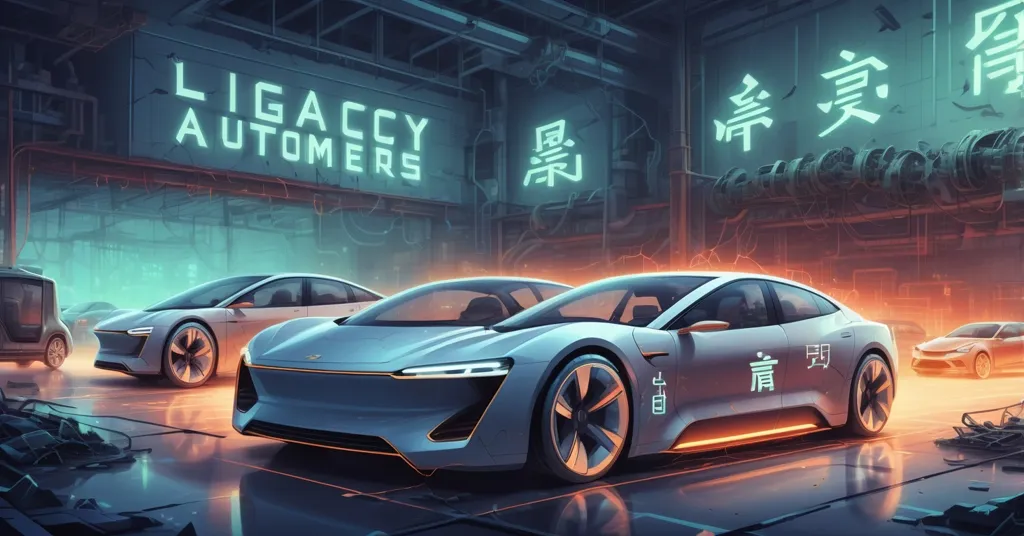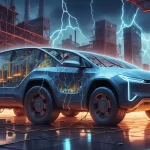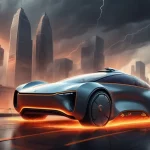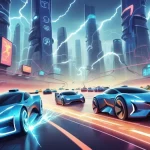Honda Crashes: Chinese EV Giants Dominate, Blockchain as Wildcard?

Honda’s Market Crash: Chinese EV Giants Are Eating Their Lunch
Honda, a name once synonymous with automotive reliability, is getting hammered. The Japanese giant has slashed its profit forecast by 20%, grappling with punishing U.S. tariffs, supply chain snags, and a brutal price war with Chinese electric vehicle (EV) makers like BYD who are stealing market share across Southeast Asia. This isn’t just a speed bump—it’s a full-on crisis for a legacy brand struggling to keep up with the electric revolution.
- Honda’s profit forecast drops 20% to 550 billion yen ($3.6 billion) for fiscal year ending March 2026.
- Chinese EV brands like BYD dominate with cutthroat pricing, slashing Honda’s sales in Indonesia by 30%.
- Strategic pivots to India and tech partnerships aim to counter losses, but the road ahead is rough.
- Blockchain could be a wildcard for automotive disruption, if Honda dares to innovate.
The Bigger Picture: EVs as the Ultimate Disruption
Before diving into Honda’s mess, let’s zoom out. The global automotive industry is undergoing a seismic shift toward electric vehicles, driven by climate concerns, government mandates, and raw consumer demand for cheaper, tech-savvy rides. This isn’t unlike the crypto revolution—where Bitcoin and blockchain challenge centralized financial dinosaurs, EVs are upending gas-guzzling relics. Legacy automakers like Honda, much like traditional banks facing decentralized finance (DeFi), are caught flat-footed as nimbler, tech-first players rewrite the rules. For our crypto crowd, this is a familiar tale: adapt or die. Honda’s struggle is a case study in what happens when the old guard sleeps on disruption.
Honda’s Financial Bloodbath: Tariffs and Losses
Let’s get to the ugly numbers. Honda has cut its operating profit outlook from 700 billion yen ($4.5 billion) to a measly 550 billion yen ($3.6 billion) for the fiscal year ending March 2026—a 20% gut punch. A hefty 385 billion yen ($2.6 billion) of that shortfall comes straight from U.S. tariffs, though that’s better than the earlier projected 450 billion yen ($2.9 billion) hit. For those scratching their heads, these tariffs are essentially a tax penalty slapped on imported goods by the U.S. to curb reliance on foreign supply chains, particularly from China. They inflate costs for companies like Honda, who rely on complex global networks, and ultimately sting consumers with higher prices. It’s a geopolitical sledgehammer, and Honda’s feeling every blow.
That’s not all. Vehicle sales projections have been downgraded to 3.34 million units, largely due to supply chain chaos. A key player in this mess is Nexperia, a semiconductor maker once owned by China’s Wingtech but now under Dutch control since late September. China’s earlier export halts on critical chips from Nexperia—likely tied to broader U.S.-China trade tensions—ground Honda’s production lines to a halt. Semiconductors, for the uninitiated, are the tiny silicon brains powering everything from your car’s infotainment to its engine. No chips, no cars. While supply issues are easing, the damage is done, and Honda’s stock took a 4.7% nosedive in a single day as investors balk at the company’s shrinking footprint. This isn’t just a bad quarter; it’s a glaring signal of vulnerability.
Chinese EVs: The Price War Honda Can’t Win
Now, let’s talk about the real enemy: Chinese EV manufacturers like BYD, who are running circles around Honda with pricing so aggressive it’s borderline predatory. Southeast Asia, a goldmine for Japanese automakers due to its booming economies and cost-conscious buyers, is slipping through Honda’s fingers. Sales in Indonesia have cratered by nearly 30% in the first nine months of the year. Malaysia’s down 18%, Thailand 12%. Across Asia, including China, Honda expects to sell just 925,000 vehicles—10% less than the earlier 1.09 million forecast. As Executive Vice President Noriya Kaihara admitted with brutal honesty:
“In markets like Thailand, the competitive landscape is quite intense and overall we have lost our competitive edge in terms of pricing.”
He’s not exaggerating. Chinese EVs, often fueled by hefty government subsidies—think tax breaks and direct grants per vehicle—plus dirt-cheap labor and production costs, are flooding markets with affordable options. BYD, for instance, has seen explosive growth in Thailand, where EVs now account for a growing chunk of new car sales. An industry insider nailed the trend, as reported in a recent analysis of Honda losing ground to Chinese automakers:
“Southeast Asia is starting to be significantly impacted by Chinese players. The growth of Chinese EVs in Thailand over the past two years has been extraordinary.”
But let’s play devil’s advocate for a second. While BYD’s price advantage is undeniable, Honda still has a card to play with brand loyalty and a reputation for engineering quality. Could it pivot to premium EV segments where price isn’t the sole decider? Possibly, but right now, they’re getting slaughtered in the budget market that drives volume in emerging economies. And with delayed launches like the Ye Series EVs in China—stalled by high costs and software bugs—Honda’s not even in the ring swinging. It’s embarrassing for a company of this stature to be caught napping while competitors lap them.
Strategic Gambles: India and Tech Partnerships
So, how’s Honda fighting back? One move is a pivot to India as a manufacturing and export hub for one of its upcoming electric vehicles. With a massive population, relatively low labor costs, and less saturation from Chinese EV brands compared to Southeast Asia, India’s a calculated bet. The country’s automotive market is projected to grow significantly, and Honda could slash production expenses while rebuilding export strength. But don’t pop the champagne yet—India’s infrastructure challenges, bureaucratic red tape, and spotty power grids could turn this dream into a logistical nightmare. This is a long-term play, not a quick fix.
Closer to the tech front, Honda’s teaming up with Momenta, a Chinese firm specializing in autonomous driving tech. For the newbies, autonomous driving means self-driving cars powered by sensors, cameras, and AI—no human needed. This partnership aims to bolster Honda’s credentials in a future where cars aren’t just electric but smart. If successful, it could give Honda an edge in China, the world’s largest EV market. Still, tech partnerships are a double-edged sword—cultural and operational mismatches could derail progress, and Honda’s already behind on basic EV rollout. Can they leapfrog straight to cutting-edge autonomy? That’s a big if.
Internally, there’s chatter about deeper cracks. Analyst Yoshio Tsukada called Honda’s profit gap “unbalanced,” pushing for a radical split of its motorcycle and auto divisions to streamline focus. It’s a ballsy idea—separating two historically intertwined units could sharpen efficiency but risks chaos during an already turbulent time. Honda’s getting crushed, and it’s partly their own damn fault for dragging their feet on electrification while competitors sprinted ahead.
Decentralized Tech: A Wildcard for Honda?
Here’s where things get interesting for our crypto crowd. While Honda’s woes are rooted in traditional industry failings, there’s untapped potential in blockchain and decentralized tech to flip the script. Imagine supply chain transparency powered by blockchain—every battery, chip, or component tracked on an immutable ledger like Ethereum, cutting fraud and ensuring ethical sourcing. Chinese EV giants might dominate on price, but trust and traceability could be Honda’s differentiator if they play it right.
Then there’s tokenized vehicle ownership. Picture buying a Honda EV not with a lump sum but through fractional ownership via NFTs or smart contracts—lowering the entry barrier for consumers in markets like India. Or consider Bitcoin micropayments for EV charging stations: plug in, pay instantly with sats, no middleman skimming fees. These aren’t pipe dreams—projects like IBM’s blockchain supply chain pilots or Ethereum-based smart contract platforms already hint at what’s possible. Honda could even explore decentralized recycling programs for EV batteries, using smart contracts to incentivize returns with tokens. If they’re serious about accelerationism—pushing tech forward fast—they’d be insane not to experiment here. But will a lumbering giant like Honda take the leap, or are they too stuck in the combustion engine era to notice the future’s already here?
Key Questions and Takeaways
- What’s behind Honda’s financial nosedive?
A brutal combo of U.S. tariffs costing 385 billion yen ($2.6 billion), supply bottlenecks like Nexperia’s chip halts, and losing ground to Chinese EVs on price. - How are Chinese EV makers like BYD outpacing Honda?
Subsidies and cheap production let them slash prices, leading to Honda sales drops of 30% in Indonesia and major losses in Thailand and Malaysia. - Can Honda’s India pivot save the day?
It’s a smart long-term move for cheaper manufacturing and exports, but infrastructure hurdles and entrenched competition make it a risky gamble. - Is splitting Honda’s divisions a viable solution?
Analyst Yoshio Tsukada thinks it could fix inefficiencies, but a restructure amid this chaos might just add fuel to the fire. - How does blockchain fit into Honda’s fight?
Decentralized tech offers potential for supply chain transparency, tokenized ownership, and micropayments—tools Honda could wield to innovate and reclaim relevance.
Honda’s battle is a microcosm of old guard versus new tech, mirroring the same fight Bitcoin wages against fiat empires. If they don’t accelerate—embracing not just EVs but radical ideas like blockchain—they’re toast. Chinese giants like BYD aren’t waiting for permission to dominate; they’re already turning Southeast Asia into their playground. Honda needs to move faster than a Bitcoin transaction in a bull run, or risk becoming a relic in a museum of failed giants. What’s the next industry ripe for this kind of disruption? That’s the question worth chewing on.



